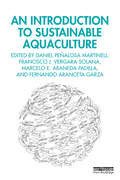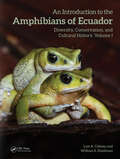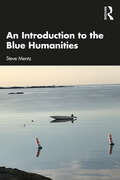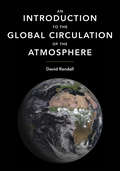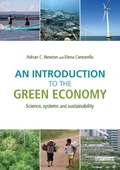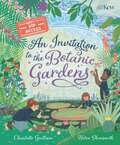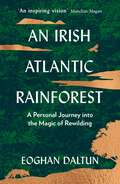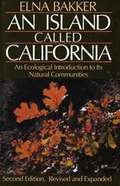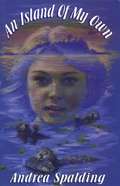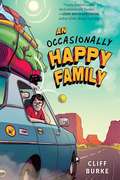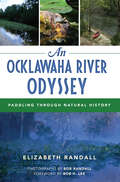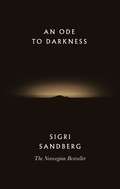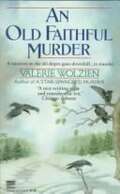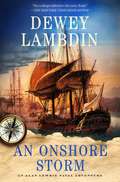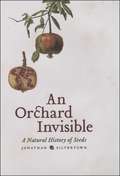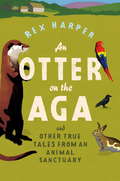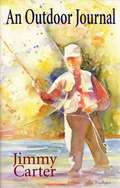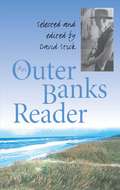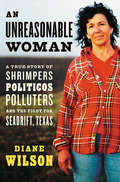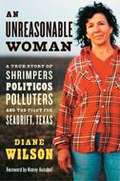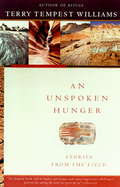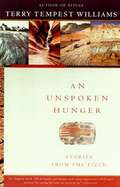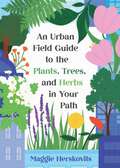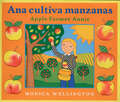- Table View
- List View
An Introduction to Sustainable Aquaculture
by Daniel Peñalosa Martinell Vergara-Solana, Francisco J Araneda Padilla, Marcelo E Fernando Aranceta GarzaThis new textbook provides an accessible introduction to sustainable aquaculture through its relationship with three key pillars: the environment, the economy, and society.As the demand for seafood keeps increasing, aquaculture is considered one of the most promising and sustainable ways to satisfy this demand with nutritious and high-quality food. It is important to understand, therefore, the wider role and impact aquaculture has on the environment, the economy, and society. The book begins by providing a foundational introduction to aquaculture and sustainability, discussing the complex and interdependent relationship that exists between the two. The core text of the book is divided into four parts which focus on the environment, economics, social impacts, and governance and technologies. Chapters examine key issues surrounding climate change, food security, new technologies, bioeconomics and risk analysis, international cooperation, employment, and animal welfare, with the book concluding with a chapter examining the future directions and challenges for the aquaculture industry. The book draws on global case studies and each chapter is accompanied by recommended reading and chapter review questions to support student learning.This book will serve as an essential guide for students of aquaculture, fisheries management, and sustainable food, as well as practitioners and policymakers engaged in sustainable fishery development.
An Introduction to the Amphibians of Ecuador: Diversity, Conservation, and Cultural History
by William E. Duellman Luis A. ColomaAn Introduction to the Amphibians of Ecuador is the first of four volumes, which are comprehensive, well-illustrated, and authoritative works, making them invaluable to biologists, conservationists, and others. This initial volume delves into the cultural history of amphibians, encompassing ethnobatrachology and folklore, while summarizing the amphibian iconography found in Ecuadorian archaeology. Moreover, it covers topics such as bioprospecting, sustainable management, and biotrade activities. The history and present state of amphibian biology research are also addressed. Furthermore, it explores in comprehensive detail the rich amphibian diversity of Ecuador, providing a thorough review of biogeography, amphibian declines, and conservation.Subsequent volumes list the characteristics of each species, define each taxon, and compare them to similar other species. Natural history and reproductive behavior, where known, are described, as are data on vocalizations, larvae, and ontogenetic changes. Amphibian distributions are illustrated with physiographic maps with dots. Each volume addresses the declines, extinctions, and conservation status of each species and provides notations of their occurrence in reserves.KEY FEATURES Summarizes the ethnozoological aspects of amphibians Provides a thorough history of research Introduction to three volumes providing accounts for each of the 3 orders, 19 families, 78 genera, and over 650 species from Ecuador
An Introduction to the Blue Humanities
by Steve MentzAn Introduction to the Blue Humanities is the first textbook to explore the many ways humans engage with water, utilizing literary, cultural, historical, and theoretical connections and ecologies to introduce students to the history and theory of water-centric thinking. Comprised of multinational texts and materials, each chapter will provide readers with a range of primary and secondary sources, offering a fresh look at the major oceanic regions, saltwater and freshwater geographies, and the physical properties of water that characterize the Blue Humanities. Each chapter engages with carefully chosen primary texts, including frequently taught works such as Herman Melville’s Moby-Dick, Samuel Taylor Coleridge’s “Rime of the Ancient Mariner,” Homer’s Odyssey, and Luis Vaz de Camões’s Lusíads, to provide the perfect pedagogy for students to develop an understanding of the Blue Humanities chapter by chapter. Readers will gain insight into new trends in intellectual culture and the enduring history of humans thinking with and about water, ranging across the many coastlines of the World Ocean to Pacific clouds, Mediterranean lakes, Caribbean swamps, Arctic glaciers, Southern Ocean rainstorms, Atlantic groundwater, and Indian Ocean rivers. Providing new avenues for future thinking and investigation of the Blue Humanities, this volume will be ideal for both undergraduate and graduate courses engaging with the environmental humanities and oceanic literature.
An Introduction to the Global Circulation of the Atmosphere
by David RandallThis is a graduate-level textbook on the global circulation of the Earth's atmosphere--the large-scale system of winds by which energy is transported around the planet, from the tropical latitudes to the poles. Written by David Randall, one of the world's foremost experts on the subject, it is the most comprehensive textbook on the topic. Intended for Earth science students who have completed some graduate-level coursework in atmospheric dynamics, the book will help students build on that foundation, preparing them for research in the field.The book describes the many phenomena of the circulation and explains them in terms of current ideas from fluid dynamics and thermodynamics, with frequent use of isentropic coordinates and using the methods of vector calculus. It emphasizes the key roles of water vapor and clouds, includes detailed coverage of energy flows and transformations, and pays close attention to scale interactions. The book also describes the major historical contributions of key scientists, giving a human dimension to the narrative, and it closes with a discussion of how the global circulation is evolving as the Earth's climate changes.The most comprehensive graduate-level textbook on the subjectWritten by one of the world's leading expertsConnects global circulation and climate phenomenaAddresses energy, moisture, and angular-momentum balance; the hydrologic cycle; and atmospheric turbulence and convectionEmphasizes the energy cycle of the atmosphere; the role of moist processes; and circulation as an unpredictable, chaotic processHelps prepare students for researchAn online illustration package is available to professors
An Introduction to the Green Economy: Science, Systems and Sustainability
by Adrian C. Newton Elena CantarelloThe green economy is widely seen as a potential solution to current global economic and environmental crises, and a potential mechanism by which sustainable development might be achieved in practice. Considerable investments are now being made into the development of green technology, renewable energy, biodiversity conservation, resource efficiency, recycling of materials and green infrastructure. This textbook provides a comprehensive introduction to the green economy, using a strongly interdisciplinary approach based on environmental science, rather than treating it as a sub-set of economics. The scientific principles of sustainability are presented, which provide the foundations of the green economy, with a particular focus on systems-based approaches. Examples of real-world case studies are used to illustrate how the green economy can be achieved in practice. In this way, the authors provide a thorough overview of both the principles and practice of the green economy, drawing from a wide range of disciplines including ecology, geography, social science, psychology, sustainability science, environmental science, law and economics. The emphasis is on presenting results of the latest research, derived from leading scientific journals. Rather than focusing on a single definition of what constitutes a ‘green economy’, the book introduces readers to the diversity of opinion that exists, and engages them in what is an active, on-going debate. This reflects the fact that many aspects of the green economy, and sustainable development more generally, are currently contested. In particular, the book will help readers to strengthen their ability to critically evaluate the evidence for and against the views presented, and to actively contribute to the future development of the green economy.
An Invitation to the Botanic Gardens
by Charlotte GuillainGrab your very own VIP access pass and explore the incredible Botanic Gardens.Have you ever wondered what goes on at the Botanic Gardens? It's not all planting and pruning. In fact, the team have a planet-saving mission on their hands – and you can help. Step off the path and follow the Garden crew who will show you behind the scenes of the Botanic Gardens with your very own access-all-areas invitation.Find out how scientists research plants that can cure diseases, watch workers wading in the waterlily pond, and discover the secrets of seeds. Find out why samples of rare and endangered plants are stored in the Herbarium and leave no leaf unturned in the tropical glasshouse. Discover insect-eating plants, zombie fungus, plants pretending to be pebbles, and more.As you turn the pages you'll learn about the importance of insects, the impact of climate change and how plants grow. With beautiful, lush illustrations, you'll discover more wonderful details each time you return to the gardens.Three large gatefolds open up to reveal even more information.
An Irish Atlantic Rainforest: A Personal Journey into the Magic of Rewilding
by Eoghan DaltunAn Post Irish Book Award Winner'An inspiring vision' Manchán Magan'The stories are absorbing, the writing charismatic and the ideas thought-provoking' Irish IndependentOn the Beara peninsula in West Cork, a temperate rainforest flourishes. It is the life work of Eoghan Daltun, who had a vision to rewild a 73-acre farm he bought, moving there from Dublin with his family in 2009. An Irish Atlantic Rainforest charts that remarkable journey. Part memoir, part environmental treatise, as a wild forest bursts into life before our eyes, we're invited to consider the burning issues of our time: climate breakdown, ecological collapse, and why our very survival as a species requires that we urgently and radically transform our relationship with nature. Powerfully descriptive, lovingly told, An Irish Atlantic Rainforest presents an enduring picture of the regenerative force of nature, and how one Irishman let it happen.
An Irish Atlantic Rainforest: A Personal Journey into the Magic of Rewilding
by Eoghan DaltunAn Post Irish Book Award Winner'An inspiring vision' Manchán Magan'The stories are absorbing, the writing charismatic and the ideas thought-provoking' Irish IndependentOn the Beara peninsula in West Cork, a temperate rainforest flourishes. It is the life work of Eoghan Daltun, who had a vision to rewild a 73-acre farm he bought, moving there from Dublin with his family in 2009. An Irish Atlantic Rainforest charts that remarkable journey. Part memoir, part environmental treatise, as a wild forest bursts into life before our eyes, we're invited to consider the burning issues of our time: climate breakdown, ecological collapse, and why our very survival as a species requires that we urgently and radically transform our relationship with nature. Powerfully descriptive, lovingly told, An Irish Atlantic Rainforest presents an enduring picture of the regenerative force of nature, and how one Irishman let it happen.
An Island Called California
by Elna BakkerBakker’s classic of ecological science now includes three new chapters on Southern California which make the book more useful than ever. Striking new photographs illustrate the diversity of life, climate, and geological formation.
An Island of My Own
by Andrea SpaldingShort-listed for the 1999 Silver Birch Award and for the 2001 Manitoba Young Readers’ Choice Award Fifteen-year-old Rowan, the daughter of foreign correspondents in Africa, finds herself beached for a summer with her cousins near Tofino, British Columbia. Desperate for a summer project, she camps on a neighbouring island to monitor the progress of an endangered group of sea otters, further threatened by the development plans of a real estate agent trying to sell the property for tourism.
An Occasionally Happy Family
by Cliff BurkeGordon Korman meets The Great Outdoors in this funny and moving debut about a boy who goes on a disastrous family vacation (sweltering heat! bear chases!) that ends with a terrible surprise: his dad's new girlfriend.There are zero reasons for Theo Ripley to look forward to his family vacation. Not only are he, sister Laura, and nature-obsessed Dad going to Big Bend, the least popular National Park, but once there, the family will be camping. And Theo is an indoor animal. It doesn&’t help that this will be the first vacation they&’re taking since Mom passed away. Once there, the family contends with 110 degree days, wild bears, and an annoying amateur ornithologist and his awful teenage vlogger son. Then, Theo&’s dad hits him with a whopper of a surprise: the whole trip is just a trick to introduce his secret new girlfriend. Theo tries to squash down the pain in his chest. But when it becomes clear that this is an auditioning-to-be-his-stepmom girlfriend, Theo must find a way to face his grief and talk to his dad before his family is forever changed.
An Ocklawaha River Odyssey: Paddling Through Natural History (Natural History)
by Elizabeth RandallPhotojournalists Bob and Liz Randall spent two years exploring Florida's ancient and enchanting Ocklawaha River. Their journey provides an inside look at the rich recreational resources of the river, its wildlife and the people, past and present, who contributed to its history and welfare. Along the way, they met artists, environmentalists, captains, law enforcement officials, conservationists, filmmakers, historians and local descendants whose lives are inextricably intertwined with the prehistoric river. From its subterranean and aquatic past to the Seminole Indian Wars, the steamboat era and political struggles, many voices are integral to the river's survival and to one of the longest environmental conflicts in Florida history.
An Ode to Darkness
by Sigri SandbergWHEN DID YOU LAST SEE THE STARS?'Look at a satellite image of the Earth. Where it was once as dark as night, it is now lit up like a Christmas tree. If you zoom in on a city, you'll see floodlights, neon lights, car lights, and streetlamps. If you zoom in even further, to your own bedroom, you might see lamps and TV, tablet, and phone screens.Humans have always struggled with the dark, but isn't it light enough now? What is all this artificial light doing to us and everything else that lives? What is it doing to our sleep patterns and rhythms and bodies?AN ODE TO DARKNESS explores our intimate relationship with the dark: why we are scared of it, why we need it and why the ever-encroaching light is damaging our well-being. Under the dark polar night of northern Norway, journalist Sigri Sandberg meditates on the cultural, historical, psychological and scientific meaning of darkness, all the while testing the limits of her own fear.
An Old Faithful Murder (Susan Henshaw Mystery #5)
by Valerie WolzienMURDER IS A FAMILY AFFAIR. The Henshaw family vacation to Yellowstone National Park promised two fun-filled weeks of fantastic scenery, great skiing, and sightseeing. Best of all, Susan's two teenagers found buddies in the Ericksen clan, who'd gathered at the lodge for their first family reunion. But there's trouble brewing among the Ericksens. A stuffed dummy dressed like the domineering patriarch is found sprawled by Old Faithful. A practical joke; obviously. But no one is laughing when the real murdered body of George Ericksen is found in the-same spot. When her reputation for solving murder cases in her Connecticut suburb is revealed, Susan is asked to find the killer. A web of twisted emotions and buried family secrets quickly unfolds, and Susan discovers everyone had reason to kill George. But who hated him enough to resort to murder at a world-famous resort? Well over half of the books in the Susan Henshaw Mystery series are ready for you in Bookshare's library with the rest on the way. Susan is the quintessential upper middle class housewife with the latest and greatest in brand name appliances, accessories and clothing to prove it. With the home front well in hand she is always poised and ready when her path intersects with murder to apply her social, domestic and other talents to solving the crimes. Look for: #1 Death at a PTA Luncheon, #2 The Fortieth Birthday Body, #3 We Wish You A Merry Murder, #4 All Hallows' Evil, #6 A Star Spangled Murder, #11 Weddings are Murder, #13 Death At A Discount, #14 An Anniversary To Die For, #15 Death in a Beach Chair and #16 Death in Duplicate.
An Onshore Storm: An Alan Lewrie Naval Adventure (Alan Lewrie Naval Adventures #24)
by Dewey LambdinFor over twenty years, Dewey Lambdin's devoted fans have followed the adventures of Alan Lewrie, Royal Navy, from his days as a midshipmen to captain of his own ship and, though on somewhat dubious grounds, a baronetcy. Now comes the latest in the Alan Lewrie naval series, An Onshore Storm, where Lewrie will take on his roughest adventure: maritime life beyond the navy.Three mismatched troop transports, lots of 29-foot barges, and an under-strength regiment of foot—a waste of Royal Navy money, a doomed experiment, or a new way to bedevil Napoleon’s army in Italy? Either way, it’s Capt. Sir Alan Lewrie’s idea, and it seems to be working, with successful raids all along the coast of Calabria. But it depends on timely information, and Lewrie must trust Don Julio Caesare, a lord of a Sicilian criminal underworld, and his minions, or the amateur efforts of a disorganized network of Calabrian partisans always in need of British arms and King George III’s money.When at last the fourth transport arrives with reinforcement troops, what seems to be a blessing could turn out to be the ruin of the whole thing! Lewrie has been too successful in his career at sea and he’s made bitter, jealous enemies with powerful patrons out to crush him and his novel squadron, no matter if it’s succeeding. And there are doings back in England that Lewrie would prefer to deal with but can’t. Lewrie has always been lucky, always finding a way to prevail—but can he this time? And if he is to be betrayed, who will do it?Lambdin has been praised as the "brilliantly stylish American master of salty-tongued British naval tales" (Kirkus Reviews) and doesn't disappoint with this riveting addition to Lewrie's adventures.
An Orchard Invisible: A Natural History of Seeds
by Jonathan SilvertownThe story of seeds, in a nutshell, is a tale of evolution. From the tiny sesame that we sprinkle on our bagels to the forty-five-pound double coconut borne by the coco de mer tree, seeds are a perpetual reminder of the complexity and diversity of life on earth. With An Orchard Invisible, Jonathan Silvertown presents the oft-ignored seed with the natural history it deserves, one nearly as varied and surprising as the earth's flora itself.Beginning with the evolution of the first seed plant from fernlike ancestors more than 360 million years ago, Silvertown carries his tale through epochs and around the globe. In a clear and engaging style, he delves into the science of seeds: How and why do some lie dormant for years on end? How did seeds evolve? The wide variety of uses that humans have developed for seeds of all sorts also receives a fascinating look, studded with examples, including foods, oils, perfumes, and pharmaceuticals. An able guide with an eye for the unusual, Silvertown is happy to take readers on unexpected--but always interesting--tangents, from Lyme disease to human color vision to the Salem witch trials. But he never lets us forget that the driving force behind the story of seeds-- its theme, even-- is evolution, with its irrepressible habit of stumbling upon new solutions to the challenges of life. "I have great faith in a seed," Thoreau wrote. "Convince me that you have a seed there, and I am prepared to expect wonders." Written with a scientist's knowledge and a gardener's delight, An Orchard Invisible offers those wonders in a package that will be irresistible to science buffs and green thumbs alike.
An Otter on the Aga
by Rex HarperIn AN OTTER ON THE AGA, Rex Harper brings to life the story of the incredible animal sanctuary that he and his family spent over forty years building. From small beginnings, the Harpers' haven became a magnet for an extraordinary array of animal waifs and strays and was designated the official RSPCA centre for Cornwall in the late 1970s, taking in more than 50,000 abused and abandoned creatures by the time Rex and his wife retired. In this tale he introduces us to the colourful cast of characters that have become his family - Patti the unlikely guard dog poodle, Odin the Machiavellian raven and One Eye the seemingly indestructible cat. He describes, too, the dark side of his work as an RSPCA warden, chronicling some of the inhuman cruelty he witnessed during his years at the forefront of animal welfare in Cornwall. Inspiring and poignant, warm and witty, AN OTTER ON THE AGA is an evocation of life close to nature, a book that will touch - and sometimes break - the hearts of animal lovers everywhere.
An Outdoor Journal: Adventures and Reflections
by Jimmy CarterFormer president Jimmy Carter writes about fly-fishing and regards it as one of the most gratifying activities of his life while reminiscing about his childhood.
An Outer Banks Reader
by David StickFor half a century, David Stick has been writing books about the fragile chain of barrier islands off the North Carolina coast known as the Outer Banks. Two of his earliest, Graveyard of the Atlantic and The Outer Banks of North Carolina, were published by the UNC Press in the 1950s, and continue to be best-sellers. More recently, Stick embarked on another project, searching for the most captivating and best-written examples of what others have said about his beloved Outer Banks. In the process, more than 1,000 books, pamphlets, periodicals, historical documents, and other writings were reviewed. The result is a rich and fascinating anthology. The selections in An Outer Banks Reader span the course of more than four and a half centuries, from the first known record of a meeting between Europeans and Native Americans in the region in 1524 to modern-day accounts of life on the Outer Banks. Together, Stick hopes, the sixty-four entries may provide both "outlanders" and natives with an understanding of why the Outer Banks are home to a rapidly growing number of people who would rather spend the rest of their lives there than any place else on earth.
An Unreasonable Woman
by Diane WilsonWhen Diane Wilson, fourth-generation shrimp-boat captain and mother of five, learns that she lives in the most polluted county in the United States, she decides to fight back. She launches a campaign against a multibillion-dollar corporation that has been covering up spills, silencing workers, flouting the EPA, and dumping lethal ethylene dichloride and vinyl chloride into the bays along her beloved Texas Gulf Coast. In an epic tale of bravery, Wilson takes her fight to the courts, to the gates of the chemical plant, and to the halls of power in Austin. Along the way she meets with scorn, bribery, character assassination, and death threats. Finally Wilson realizes that she must break the law to win justice: She resorts to nonviolent disobedience, direct action, and hunger strikes. Wilson's vivid South Texas dialogue resides somewhere between Alice Walker and William Faulkner, and her dazzling prose brings to mind the magic realism of Gabriel Garcia Marquez, replete with dreams and prophecies.
An Unreasonable Woman: A True Story of Shrimpers, Políticos, Polluters, and the Fight for Seadrift, Texas
by Diane WilsonFor her activism on behalf of Texas Gulf Coast bays, Wilson has been recognized with awards including Mother Jones' Hellraiser of the Month. In her first book, this fourth-generation shrimper relates her battles against a plastics company (and their political allies) whose dumping of toxic chemicals resulted in her county's designation as the nation's most polluted in the late 1980s. Annotation ©2005 Book News, Inc., Portland, OR (booknews.com)
An Unspoken Hunger
by Terry Tempest WilliamsWilliams weaves her observations in the naturalist field and her personal experience--as a woman, a Westerner, and a Mormon--into a resonant manifesto on behalf of the landscapes she loves, making clear as well that, through our disregard of this world, we have lost an essential connection to our deepest selves.
An Unspoken Hunger: Stories from the Field
by Terry Tempest WilliamsWilliams weaves her observations in the naturalist field and her personal experience--as a woman, a Westerner, and a Mormon--into a resonant manifesto on behalf of the landscapes she loves, making clear as well that, through our disregard of this world, we have lost an essential connection to our deepest selves.
An Urban Field Guide to the Plants, Trees, and Herbs in Your Path
by Maggie HerskovitsBefriend the plants in your neighborhood. Imagine going for a walk with a knowledgeable friend who points out all the plants you see and the coolest facts about them. This practical field guide is that friend, providing a delightful introduction to 57 of the plants, trees, weeds, and herbs you’ll encounter walking around most US cities. Accurate, charming line drawings accompany detailed yet accessible botanical information about each plant that helps you easily identify it in all seasons. You’ll also learn each plant's backstory, including its relatives, origins, historical uses, and other fun facts. Getting to know the plants you meet every day will help you strengthen your sense of place, improve your foraging game, make new botanical and herbal friends, and marvel at the life that is all around us.
Ana Cultiva Manzanas / Apple Farmer Annie
by Monica WellingtonA delicious treat about America's favorite fruit is now available in a Spanish bilingual format. Ana grows and sells apples, and she makes cider and applesauce and muffins. A glossary helps kids learn the names of Ana's delicious ingredients in both languages. With tie-ins to math and science curricula and units on autumn, this book will be especially welcomed by teachers. Truly the pick of the crop!
